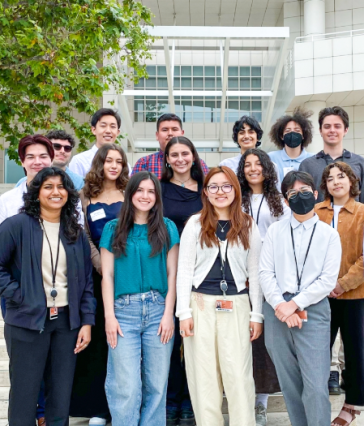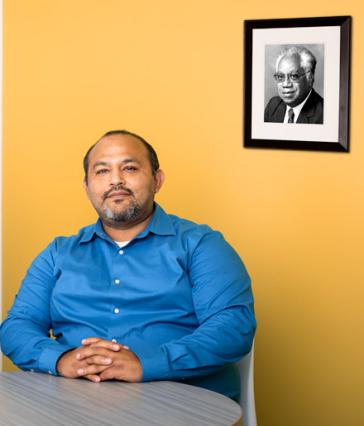CSULB biology professor receives Wang Award for creating innovative mentoring program
Cal State Long Beach Professor Kelly Ansley Young easily recalls the person — or people, rather — who had the most significant impact on her career.
Young was studying biology as an undergrad when two chemistry professors, a married couple, noticed her talent and became her de facto mentors. The arrangement wasn’t formal; they weren’t even in her department. But their attention, encouragement, and advice left an impression.
“They believed in their students,” Young said recently from her reproductive research lab in the heart of CSULB’s College of Natural Sciences and Mathematics. “They saw our potential, even when we couldn’t.” As a woman in STEM in the 1990s, Young was particularly moved by her mentors’ genuine confidence that she could achieve remarkable feats in her field.
It turns out they were right.
Young, who recently celebrated her 20th year in the Department of Biological Sciences, has been selected as a recipient of the Wang Family Excellence Award for Outstanding Faculty Innovator in Student Success. One of only five recipients — four California State University faculty and one staff member across all 23 campuses — Young and her colleagues were honored at a ceremony during the Board of Trustees meeting Jan. 30.
Endowed by Trustee Emeritus Stanley Wang, the Wang Award accompanies a $20,000 cash prize and honors unwavering commitment to CSU student achievement. Young’s category recognizes campus innovators whose “creative and exemplary teaching practices support positive faculty-student relationships.”
Young’s innovation? A mentoring training program estimated to benefit up to 140,000 CSU students in the coming years.
Mentoring the mentors
Although Young has led the creation of several mentoring initiatives over the years, the most far-reaching is Advancing Inclusive Mentoring (AIM), an offshoot of an earlier "mentoring-the-mentors" program funded by the National Institutes of Health. With a focus on mentorship through an equity and inclusivity lens, AIM — which goes by Beach Mentor on the Long Beach campus — introduces professors to a compendium of best practices and offers a template for establishing a community in which professors can guide and support each other. The program was so successful that Young eventually took it on the road; to date, more than 600 professors have completed AIM, and Young has personally led trainings on 11 CSU campuses — nine of which have chosen to adopt the program themselves.
Evidence shows how effective and important a good mentor can be, particularly to college students, but it's not something that comes naturally or easily to everyone, even teachers.
“It’s a different skillset,” Young said. “You aren't lecturing. You are working with [students] on hands-on research. And you are doing things that have never been done before, so you don’t know if it’s going to work. It’s real science.”
For that reason, AIM prepares mentors to expect the unexpected, gives them problem-solving techniques and shows them how to navigate personalities — not to mention power dynamics — while still moving the research along. Mentoring requires a subtle back and forth, Young said, as professors must constantly decide whether to step back or step in.
For CSULB President Jane Close Conoley, who nominated Young for the Wang Award, it’s that kind of mentoring that makes it possible for college labs to become truly student-run.
“Dr. Young’s research laboratory has always been a place where her students take center stage,” Conoley said. “They are researchers, not helpers or observers.”
Young agreed. “It’s not just about passing on a skill,” she said. “It’s really about getting students excited about their future.”
Dream job
The chemistry professors who made such a mark on Young in undergraduate school at Cal Poly San Luis Obispo were Professors Emeriti Philip and Christina Bailey, whose work and mentorship in the Chemistry and Biochemistry Department inspired thousands of students. So many, in fact, that the university recently christened the Philip and Christina Bailey College of Science and Mathematics.
Young credits the Baileys’ guidance with inspiring her to become a CSU professor in the first place. Even while pursuing her doctorate in biochemistry and molecular biology at the Johns Hopkins Bloomberg School of Public Health in Baltimore, Young kept her sights on California. A handwritten sign above her desk acted as a sort of talisman.
The sign read "PHD = CSU.” It worked.
In 2003, when CSULB listed an opening for a reproductive biology teacher, Young knew she was looking at her dream job.
“I really consider myself lucky to have worked with so many incredible students, faculty and staff members at CSULB and across the CSU,” said Young, who also serves as CNSM’s director or faculty retention.
Young said she was deeply touched to be honored with the Wang Award and hoped to be able to fund more research with part or all of the prize money. But the greatest gift, she said, is being able to do what she loves: finding new and inspiring ways to support, encourage and guide young scientists.
These days, as she mentors students through genetic-testing experiments in her campus lab, she said she is constantly impressed by her mentees’ hard work and enthusiasm — and finds it incredibly easy to see their potential.
Even when they can't.

















